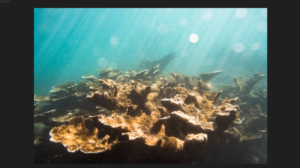SAN JUAN (WaPo) — Hurricanes, earthquakes and an outbreak of a fast-spreading coral disease have wreaked havoc on the coral reefs that protect Puerto Rico’s shores in recent years. Now, the federal government has for the first time allocated disaster relief funding to help rebuild coral reefs in San Juan Bay.
In June, the Federal Emergency Management Agency announced that it had allocated $3 million for the first phase of a $38.6 million initiative to restore the bay’s coral reef barrier, which acts as a natural breakwater that defends the communities around the bay from coastal flooding. The reef has recently eroded, leaving the three-mile bay area vulnerable to flooding and large storm surges.
The restoration project will protect about 800 structures in nearby communities, officials say, and help insulate island residents from the effects of future storms.

Elkhorn coral at Tres Palmas Marine Reserve in Rincón, Puerto Rico. (iStock)
Healthy reefs serve as rich marine habitats that also protect coastal areas. But even before severe weather further damaged the bay’s reefs, Puerto Rico’s corals were beset by a variety of contagious diseases that discolor and even kill them. The most recent, stony coral tissue loss disease, has spread to reefs around the island, killing up to 50 percent of corals in some spots.
In 2021, Puerto Rico Gov. Pedro Pierluisi (D) declared an ecological emergency because of the coral disease; this year, he declared a state of emergency related to coastal erosion.
The restoration project involves creating a system of hybrid reefs that include both cement structures and native living corals. An artificial reef will also be constructed near Condado Beach, a popular tourist destination that has been a hot spot for drownings because of rough surf and strong riptides.
Beachgoers won’t be the only ones to benefit: Coral reefs are prized habitats for marine life, and Puerto Rico’s reefs protect commercial fish as well as nesting endangered sea turtles. During nesting season, leatherback turtles return to beaches along the bay to lay eggs.
Conservationists and scientists have long advocated reef restoration as part of federal disaster risk reduction policies, and in recent years FEMA has increasingly embraced nature-based hazard mitigation practices. But agency officials say this is the first time it has allocated a hazard mitigation grant to restore a natural resource to protect survivors after a disaster.
“This historic obligation will undoubtedly open the door for similar initiatives that address the effects of climate change and its impact on communities,” said José G. Baquero, FEMA’s federal disaster recovery coordinator for Puerto Rico, in the statement.
By ERIN BLAKEMORE/Washington Post

